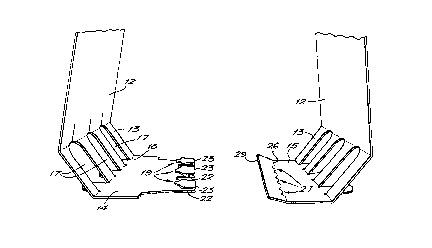Some of the information on this Web page has been provided by external sources. The Government of Canada is not responsible for the accuracy, reliability or currency of the information supplied by external sources. Users wishing to rely upon this information should consult directly with the source of the information. Content provided by external sources is not subject to official languages, privacy and accessibility requirements.
Any discrepancies in the text and image of the Claims and Abstract are due to differing posting times. Text of the Claims and Abstract are posted:
| (12) Patent Application: | (11) CA 2202386 |
|---|---|
| (54) English Title: | PAPERBOARD INTERLOCK ARRANGEMENT |
| (54) French Title: | SYSTEME D'ASSEMBLAGE PAR ENCHEVETREMENT POUR MORCEAUX DE CARTON |
| Status: | Deemed Abandoned and Beyond the Period of Reinstatement - Pending Response to Notice of Disregarded Communication |
| (51) International Patent Classification (IPC): |
|
|---|---|
| (72) Inventors : |
|
| (73) Owners : |
|
| (71) Applicants : |
|
| (74) Agent: | GOWLING WLG (CANADA) LLP |
| (74) Associate agent: | |
| (45) Issued: | |
| (86) PCT Filing Date: | 1995-10-17 |
| (87) Open to Public Inspection: | 1996-05-02 |
| Availability of licence: | N/A |
| Dedicated to the Public: | N/A |
| (25) Language of filing: | English |
| Patent Cooperation Treaty (PCT): | Yes |
|---|---|
| (86) PCT Filing Number: | PCT/GB1995/002448 |
| (87) International Publication Number: | WO 1996012656 |
| (85) National Entry: | 1997-04-10 |
| (30) Application Priority Data: | ||||||
|---|---|---|---|---|---|---|
|
There is provided an interlock arrangement for two pieces of paperboard. The
arrangement comprises at least one flap (19) projecting from one piece, the
leading portion (20) of which flap (19) is folded back about a waist section
fold line (23). The leading portion (20) has laterally projecting portions
(21) and is inserted through an opening (27) cut into the other piece of
paperboard. The lateral projections (21) pass through the opening then tend to
spring up so as to prevent withdrawal. The tip of the leading portion (20)
remains held by the opening cut thereby ensuring that the flap (19) remains
double thickness when engaged in the opening (27).
L'invention concerne un système permettant d'assembler par enchevêtrement deux morceaux de carton. Ledit système comprend au moins un volet (19) faisant saillie à partir d'un des morceaux de carton, dont la partie avant est rabattue autour d'une ligne de pliage (23) de la partie centrale. La partie avant (20) comporte deux parties (21) faisant saillie latéralement et est introduite dans une ouverture (27) découpée dans l'autre morceau de carton. Les saillies latérales (21) traversent ladite ouverture et ont tendance à remonter par un effet de ressort, ce qui empêche leur retrait. La pointe de la partie avant (20) est retenue par le bord de l'ouverture, ce qui garantit que le volet (19) conserve sa double épaisseur lorsqu'il est introduit dans l'ouverture (27).
Note: Claims are shown in the official language in which they were submitted.
Note: Descriptions are shown in the official language in which they were submitted.

2024-08-01:As part of the Next Generation Patents (NGP) transition, the Canadian Patents Database (CPD) now contains a more detailed Event History, which replicates the Event Log of our new back-office solution.
Please note that "Inactive:" events refers to events no longer in use in our new back-office solution.
For a clearer understanding of the status of the application/patent presented on this page, the site Disclaimer , as well as the definitions for Patent , Event History , Maintenance Fee and Payment History should be consulted.
| Description | Date |
|---|---|
| Application Not Reinstated by Deadline | 2003-10-17 |
| Inactive: Dead - RFE never made | 2003-10-17 |
| Deemed Abandoned - Failure to Respond to Maintenance Fee Notice | 2003-10-17 |
| Inactive: Abandon-RFE+Late fee unpaid-Correspondence sent | 2002-10-17 |
| Letter Sent | 1997-09-18 |
| Inactive: First IPC assigned | 1997-08-06 |
| Inactive: IPC assigned | 1997-08-06 |
| Inactive: Notice - National entry - No RFE | 1997-07-04 |
| Inactive: Applicant deleted | 1997-07-03 |
| Inactive: Single transfer | 1997-06-10 |
| Inactive: Courtesy letter - Evidence | 1997-05-13 |
| Application Published (Open to Public Inspection) | 1996-05-02 |
| Abandonment Date | Reason | Reinstatement Date |
|---|---|---|
| 2003-10-17 |
The last payment was received on 2002-10-04
Note : If the full payment has not been received on or before the date indicated, a further fee may be required which may be one of the following
Please refer to the CIPO Patent Fees web page to see all current fee amounts.
| Fee Type | Anniversary Year | Due Date | Paid Date |
|---|---|---|---|
| Basic national fee - standard | 1997-04-10 | ||
| Registration of a document | 1997-04-10 | ||
| MF (application, 2nd anniv.) - standard | 02 | 1997-10-17 | 1997-09-24 |
| MF (application, 3rd anniv.) - standard | 03 | 1998-10-19 | 1998-09-30 |
| MF (application, 4th anniv.) - standard | 04 | 1999-10-18 | 1999-10-01 |
| MF (application, 5th anniv.) - standard | 05 | 2000-10-17 | 2000-10-05 |
| MF (application, 6th anniv.) - standard | 06 | 2001-10-17 | 2001-10-04 |
| MF (application, 7th anniv.) - standard | 07 | 2002-10-17 | 2002-10-04 |
Note: Records showing the ownership history in alphabetical order.
| Current Owners on Record |
|---|
| RIVERWOOD INTERNATIONAL CORPORATION |
| RIVERWOOD INTERNATIONAL CORPORATION |
| Past Owners on Record |
|---|
| NATHALIE BRIAND |